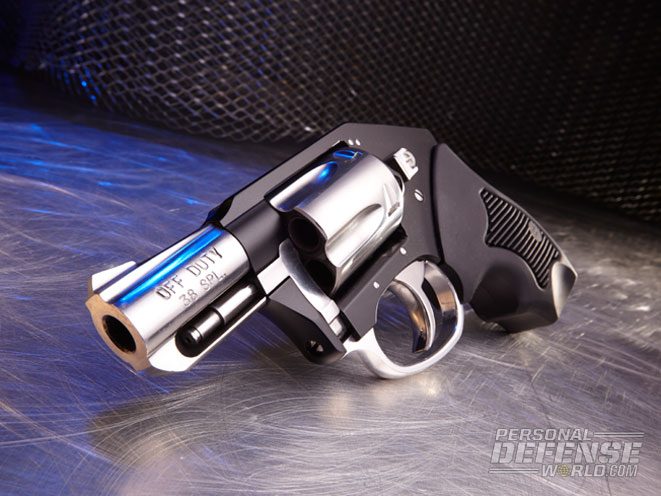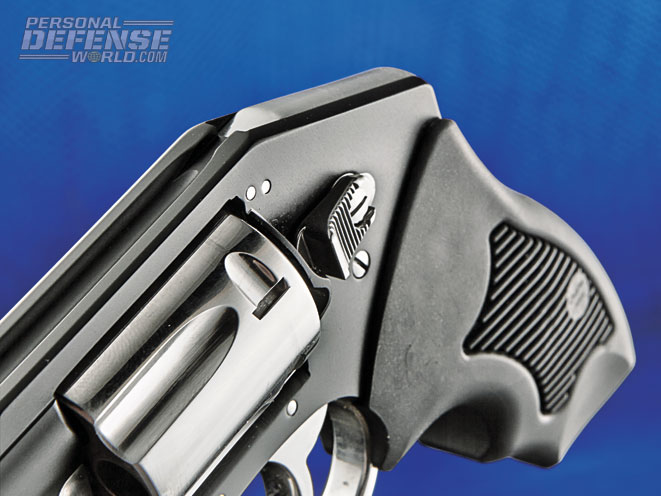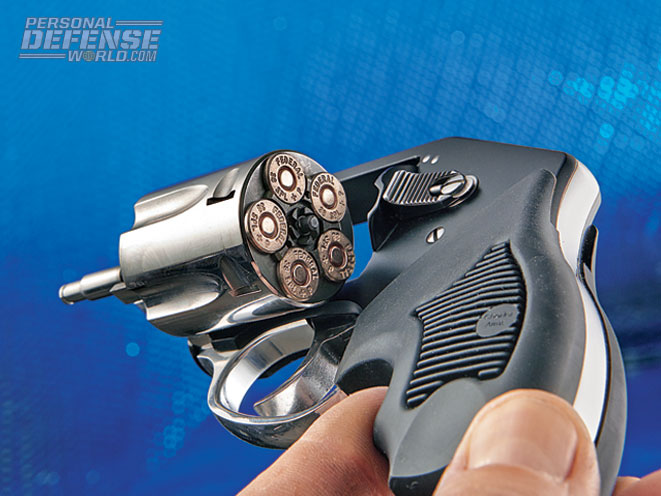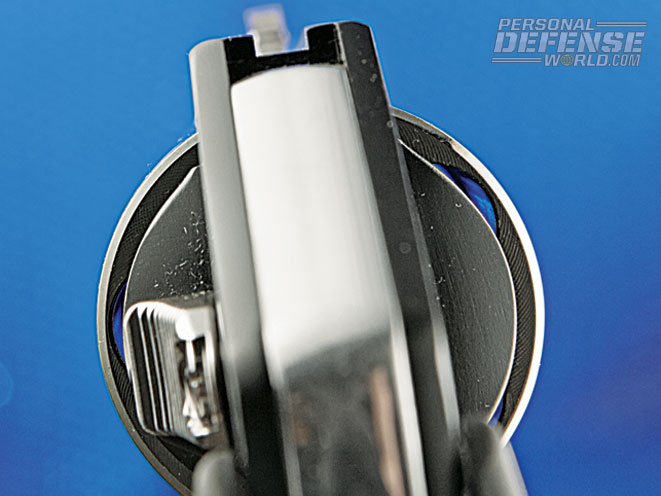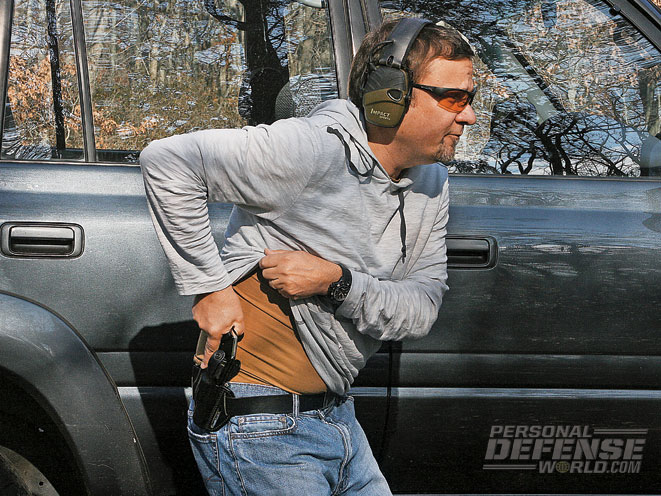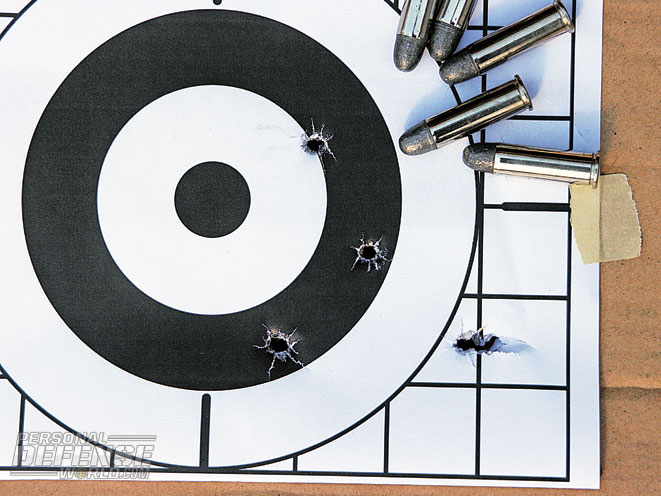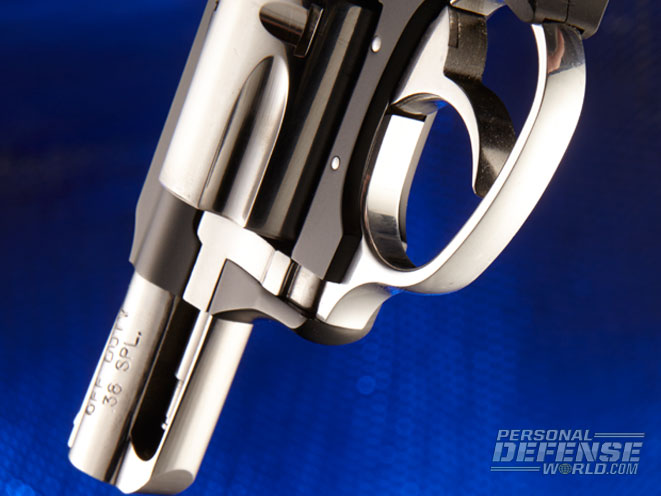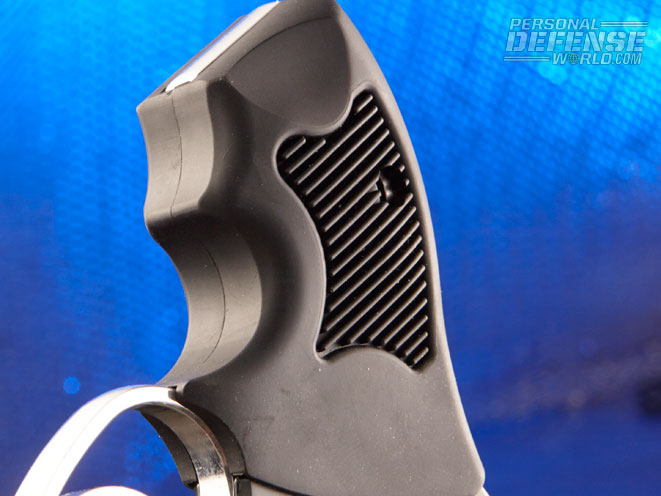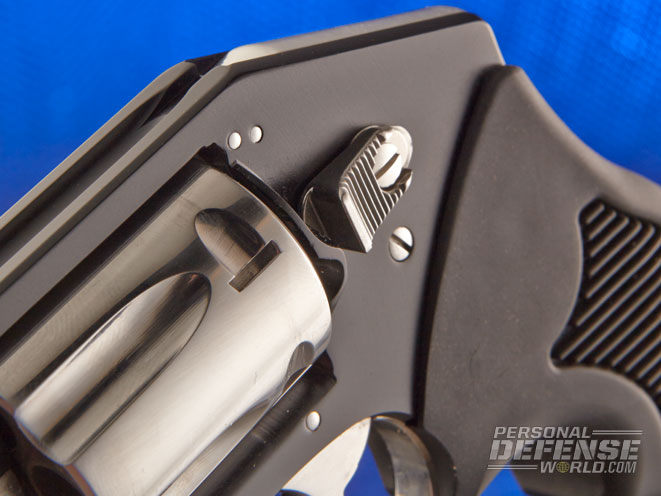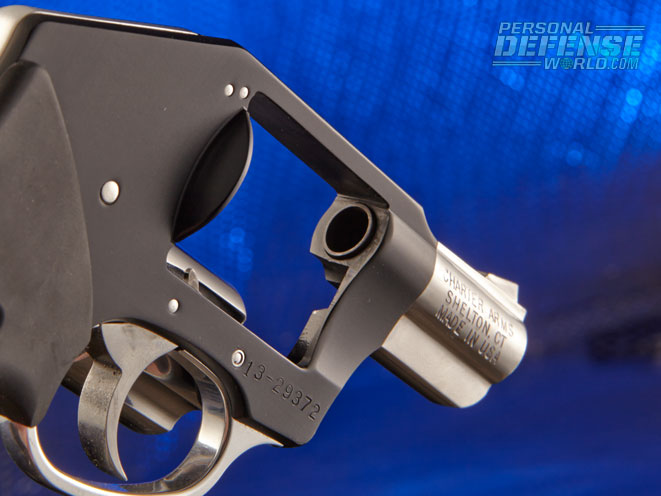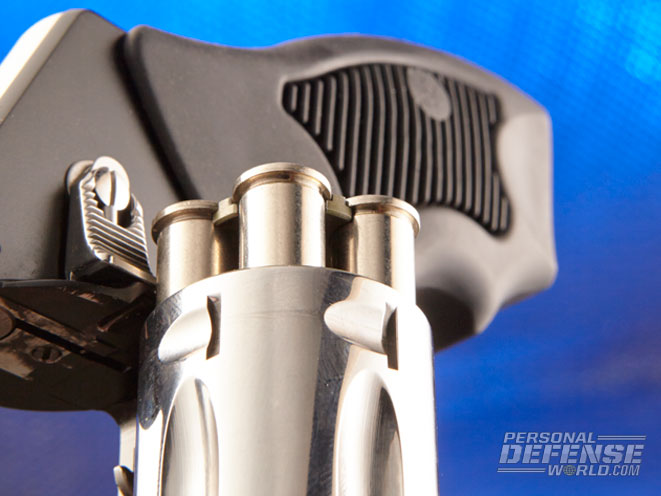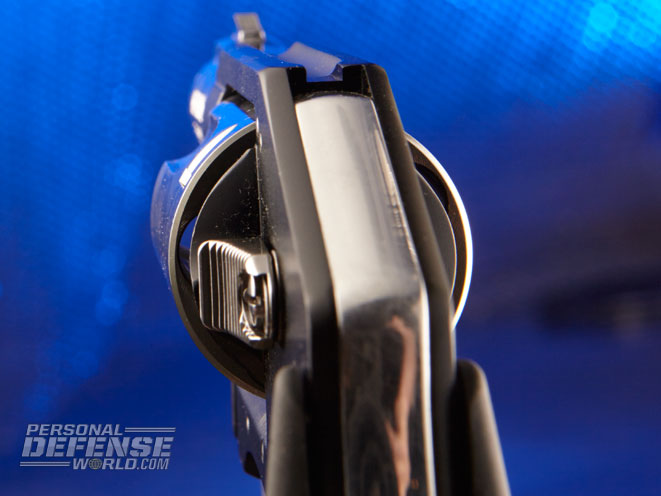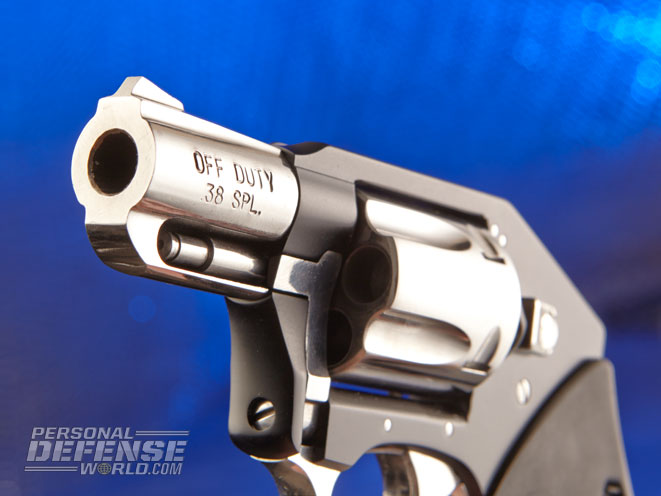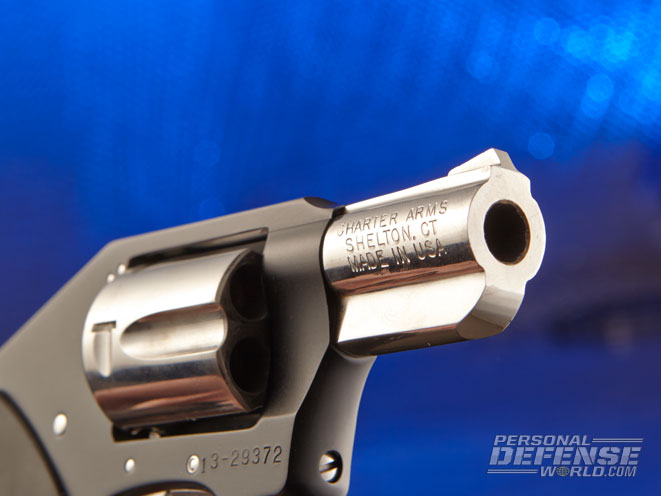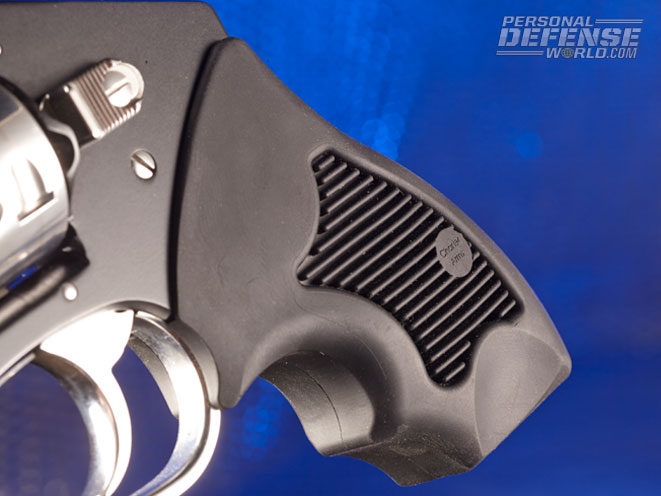Firearms are a reflection of our personality and character. Bat Masterson special ordered a Colt SAA with a nickel finish, gutta-percha grips and requested that it be “light on the trigger.” Colonel Jeff Cooper’s 1911 is sort of a parts gun with a Commander-style hammer, an arched/checkered mainspring housing and an ivory grip with a water buffalo etched into it. Jerry Miculek’s IDPA revolver is a stock S&W 625 JM tweaked with a green HiViz front sight, a Bowen white outline rear sight, a bobbed hammer and Miculek’s smooth, hardwood grips.
The Charter Arms Off Duty has a finish that looks good in hand. The barrel, cylinder, triggerguard and frame are stainless steel polished to a bright, glossy finish that’s as shiny as chrome plating. The silver-and-black revolver reminds me of a laid back panhead I once knew that had just enough chrome on the V-twin and pipes, and a black, lacquered gas tank between your legs. The dual-tone Off Duty revolver looks sharp. It has a bad boy look to it, but can it walk the walk?
More With Less
Advertisement — Continue Reading Below

The Off Duty is manufactured from 7075 aluminum and stainless steel and weighs 12 ounces. The revolver is light in the hand. The weight of the pistol is almost equal to five 158-grain .38 Special cartridges. The frame is built from heat-treated aluminum and wears a semi-gloss black finish. The barrel and cylinder are made from stainless steel that’s been given a high-gloss polish that is as shiny and glossy as chrome exhaust pipes. The remainders of the parts—pins, triggerguard/backstrap, trigger cylinder latch, crane, ejector rod—are all brightly polished. Like all Charter Arms revolvers, the Off Duty has a solid frame. There is no side plate, like there is on Smith & Wesson or Taurus revolvers. Ruger uses a similar one-piece frame like the Charter Arms model. There are fewer internal parts in the Charter Arms model (about 40 parts in total), and the parts are all hand-fitted by the skilled technicians at Charter Arms’ manufacturing facility. To access the innards of a Charter Arms pistol, the triggerguard/backstrap is removed and the trigger, hammer, pawl, etc., are removed from the bottom of the frame. The barrel is threaded into the frame and is one piece. It has a full lug that is rounded at the muzzle, which helps aid in holstering the piece. The lug also completely encloses the revolver’s ejector rod assembly.
RELATED: Charter Arms Pitbull 9mm
The Off Duty is truly snag-free. It can be carried in a holster, dropped into a pants pocket or in a coat pocket without the conspicuous, telltale print. The front sight is milled into the barrel and the ramp is serrated to reduce glare. The front sight, like the rest of the barrel, is brightly polished. In bright light the sight glistens, but the serrated ramp lessens glare just like it is suppose to do. The rear sight consists of a groove milled into the top of the frame. The rear groove is wide so the front sight is easy to pick up and get on target quickly.
Advertisement — Continue Reading Below

The trigger’s surface is smooth. The trigger pull is also smooth, and the shape of the triggerguard ensures the shooter’s trigger finger does not get pinched between the bottom edge of the trigger and the inside of the triggerguard. To load the Off-Duty, the cylinder latch is pushed forward using the thumb of your shooting hand (if you are a right-handed shooter). The cylinder can then be swung out of the frame with the free hand. The shape of the cylinder latch, and the serrations milled into it, give the user a sure grip. When loading and unloading the Off Duty, the cylinder locked in place with a distinct, reassuring click. The crane is also different from a Taurus or S&W revolver, and Ruger, too. The crane on the Charter Arms Off Duty fits into a groove cut into the side of the frame. On a Ruger, S&W or Taurus, the crane and frame sandwich together.
The Off Duty is a hammerless design, which really means the hammer is enclosed by the frame. The revolver employs a hammer-block safety system that blocks the hammer from making contact with the firing pin. Only when the trigger is pulled can the hammer make contact with the firing pin, which is built into the frame. If the Off Duty is accidentally dropped, the weapon will not discharge. The metal work is all nicely smoothed, allowing the Off Duty to easily slip into pockets or holsters.
Grips can sometimes impede concealed carry by hanging up on clothing or imprinting, but the finger-groove grips on the Off Duty are small and compact. There is no imprint, but the gun fills your hand. The rear backstrap is exposed on the revolver with the rubber grips. The front strap, however, is fully enclosed. Charter Arms did a good job of filling that space behind the triggerguard with grip material. The two finger grooves of the grip automatically position the middle finger and the ring finger, while the small finger curls under the butt. The feel in hand allowed me to naturally point the revolver, and it placed my hand slightly higher on the gun so the 12-pound trigger pull felt a lot lighter. The higher grip placement also allowed better control during rapid-fire strings. The sides of the grips have a slight palm swell so the Off Duty fills your hand without any added bulk. The horizontal grooves in the grips also helped keep the revolver in hand when firing rounds.
Advertisement — Continue Reading Below
On-Range Duty

The Off Duty can handle .38 Special +P cartridges, but with the dearth of .38 ammo on dealers’ shelves I was only able to assemble an assortment of regular .38 Special loads: Federal American Eagle 130-grain full metal jacket (FMJ), Winchester Cowboy 158-grain lead flat nose, and Winchester Super-X 158-grain lead round nose. The 158-grain lead round nose loads were a law enforcement staple back when wheelguns were carried, and over the years law enforcement agencies amped up the .38 Special load with +P velocities. If I had my druthers, and could find the ammo, I would load the Off-Duty with +P 158-grain lead semi-wadcutter hollow points. Of course, I would need to test the load in the revolver to see if the ammo functioned accurately and properly. Something to note when choosing hot +P ammo for lightweight revolvers, inertia from the recoil of the hot loads can cause lead bullets to move forward in the cartridge case. The extended cartridge will then jam the revolver as the extended bullet will not allow the cylinder to rotate. Despite this, I did not encounter any issues with the ammo I used during my tests.
RELATED: Charter Arms Pathfinder
Advertisement — Continue Reading Below
Lightweight guns can offer harsh recoil so I eased into shooting using the Winchester Cowboy loads. The shape of the grip made a big difference in the Off Duty. It was a pleasure to shoot. The trigger pull was smooth and it was easy to keep five rounds at rapid fire within the 12-inch diameter of a D-1 “Tombstone” target at 15 yards. The Federal American Eagle and Winchester Super-X were just as pleasant to shoot, and I think the Off Duty could even be used in an IDPA Back-Up Gun competition. It was accurate and easy to control when shooting fast, and my hand did not feel like my palm was beaten with a wooden ruler. The velocity of all the ammo was within 100 fps (feet per second) and bullet weight was close, and I found no real recoil differences. I did like the fact that I could cluster bullet holes into 1.5-inch groups consistently at 15 yards using a rest. Not bad with a DAO (double-action-only) gun. The 12 pounds of trigger pull seemed less because of the grip design, so no complaining on my end. The ejector on the Off Duty is not full size, which means it pushes empties out about halfway. Use the ejector with gravity to quickly unload the “five-shooter.”

I liked the firepower the Off Duty provided so I loaded up with Winchester Super-X ammo for concealed carry. Usually when I am at home I remove my concealed-carry piece from my person and place it in a secure area, but with the lightweight Off Duty I found I forgot about the revolver and wore it at my desk, doing chores around the house as well as doing errands around town. I carried a BlackHawk three-slot holster designed for an S&W J-frame to tote the Off Duty. The BlackHawk holster has a thumb-snap retainer that worked with the hammerless design of the Charter Arms revolver, too. The black, leather holster suited the Off Duty perfectly. Other times I slipped the piece in my vest pocket when taking my dogs on a run. The Off Duty revolver proved to be an easy carry weapon, and I tend to be lazy, so a gun that is convenient, easy to carry and still provides firepower usually wins over larger, heavier pieces for everyday concealed carry.
The Charter Arms Off Duty suits the purpose for a lightweight, hammerless .38 Special. It is easy to carry, looks smart and can walk the walk.
Advertisement — Continue Reading Below
For more information, visit http://www.charterfirearms.com or call 203-922-1652.
